Ijraset Journal For Research in Applied Science and Engineering Technology
- Home / Ijraset
- On This Page
- Abstract
- Introduction
- Conclusion
- References
- Copyright
Crop Recommendation and Monitoring using AI
Authors: Sri Hari Nallamala, Dhanalakshmi Meghana Majeti, Venkata Pranay Pendyala, Sanghamitra Neela, Bhanu Prakash Nambari
DOI Link: https://doi.org/10.22214/ijraset.2024.59061
Certificate: View Certificate
Abstract
Agriculture is crucial for India\'s economy, with over 50% relying on it for survival. Climate and weather variations pose risks to agriculture\'s health. AI can monitor crops by using machine learning methods. Crop monitoring includes Crop Recommendation, Weed Detection, Plant Disease Detection, Yield Prediction. The models are trained with Image and numerical datasets. A website will be developed to monitor crops and provide solutions. The optimal crop can be suggested based on the surrounding conditions by analysing important variables like composition of Nitrogen, Phosphorous and Potassium in the soil, its pH value, humidity, and rainfall using various models namely Gaussian Naive Bayes, Logistic Regression, Gradient boosting, Ensemble which fall under the domain of Machine Learning. ANN can be used for crop yield prediction. Weed and Plant disease can be detected using ResNet which can be utilized for deep neural networks. The intent of this project is to help farmers choose suitable crops, differentiate crops from weeds, detect diseases, provide remedies to protect crop. It enables to improve yield and productivity, Enhanced sustainability, Increased Profitability.
Introduction
I. INTRODUCTION
For both human survival and the Indian economy, agriculture is important. It is one of the main jobs that are necessary for human survival. It also makes a significant contribution to our daily lives. Getting the most crop output at the lowest possible cost is one of the objectives of agricultural production. Crop yield indicators can lead to increased production and profit if issues are identified early and managed. The growth of crops is affected due to parallel growth of weeds and diseases at various crop stages. Weeds are nothing but it grabs the nutrition from the sun and water and competes with the crop, and destroys the quality of cultivation.
The Crop Recommendation and Monitoring System (CRMS) emerges as a groundbreaking tool to address these challenges. CRMS is an integrated digital platform designed to assist farmers in making informed decisions regarding crop selection, cultivation practices, and resource management. This system leverages advanced technologies such as artificial intelligence, machine learning, and deep learning to provide timely and data-driven recommendations. Artificial Intelligence provides computational intelligence such that the machines can learn, understand, and respond according to varying situations. It can be used to improve crop yields by monitoring crop growth and identifying issues such as diseases and pest infestation.Significantadvantages, such as better agricultural output, increased profitability, and enhanced sustainability, could result from the use of this technology. Nonetheless, it is critical to recognize that the system's performance may be impacted by several constraints, including contextual factors, local variability, and the availability and quality of data. However, the main objective is to utilize AI and machine learning's potential to transform the agriculture industry and contribute to food security and economic growth in India.
The use of AI and machine learning algorithms for crop monitoring is at the heart of these approaches, providing a data-driven response to the ever-changing problems the agriculture industry faces. Important elements of the research include early detection of plant illnesses, precise crop yield prediction, and crop and weed detection. The creation of machine learning models, such as ensemble models, Gradient Boosting, Logistic Regression andGaussian Naive Bayes, is suggested to help achieve these goals. A comprehensive understanding of crop health and possible problems is made possible by the fact that these models are trained on both picture and numerical datasets.The study also analyses important variables that impact crop growth, such as pH levels, humidity, rainfall, and soil composition (nitrogen, phosphorus, and potassium). These elements are essential for creating accurate crop recommendations, matching crop choices to environmental circumstances, and enhancing agricultural decision- making. Enhancing the project's capabilities is the incorporation of artificial neural networks (ANN) for agricultural yield prediction. Furthermore, for pixel-level detection of crops, weeds, and plant diseases, sophisticated image processing methods as ResNet are used. Because of this granular approach, the system can identify problems with a high degree of precision. The project involves creating a user-friendly website to help farmers and agricultural specialists understand these approaches.
This platform ensures full support and solutions by facilitating data input, offering real-time crop health monitoring, and connecting customers with agricultural professionals. This project's main objective is to assist farmers in making informed crop selections, identifying crops from weeds, recognising and treating plant illnesses, and gaining access to agricultural experts. The project hopes to increase crop output, sustainability, and overall profitability in the agriculture industry.These approaches have a lot of potential, but they also have certain drawbacks. It is known that there are difficulties with data availability and quality, contextual considerations, and local variability. For the system to be implemented successfully and to reach its maximum potential in supporting agricultural practices, several restrictions must be addressed.
II. LITERATURE REVIEW
Agriculture is the backbone of many economies, especially in countries like India, where a significant portion of the population relies on it for sustenance. However, the sector faces various challenges, including unpredictable climate patterns and the prevalence of diseases and pests. In recent years, there has been a growing interest in leveraging artificial intelligence (AI) and machine learning (ML) techniques to address these challenges and optimize agricultural practices.
TABLE I
COMPARISION TABLE FOR MODEL PAPERS
|
Base paper |
Model and accuracies |
Our models and accuracies |
|
[1] |
KNN(96.36), DT(86.64), RF(97.18), XGBoost(95.62), SVM(87.38) |
Naïve Bayes(99.09), Logistic regression(95.22), Gradient boosting(99.318) |
|
[2] |
MobileNet(96.31), SqueezeNet(95.05), NasNetMobile(95.09), MobileNetV2(94.59), ShuffleNet(91.50) |
ResNet9(99.2) |
A novel method for plant disease identification using picture texture analysis and tiny neural networks for Bayesian optimization is proposed by Restrepo-Arias et al. (2022)[1]. The goal of the project is to increase agricultural crop diseasedetection’s efficacy and precision.The authors improve disease detection skills by using image texture attributes that are extracted from plant photos.In order to maximize the effectiveness of tiny neural networks for illness categorization, Bayesian optimization techniques are utilized. The outcomes of the experiments show how well the suggested method works to correctly identify different plant diseases, which enhances agricultural management techniques.
A cloud-enabled platform powered by machine learning algorithms for crop recommendation in precision farming is presented by Thilakarathne et al. (2022)[2]. In an effort to maximize farming methods and raise output, the platform uses sensor data and cloud computing to give farmers customized crop advice.The authors create a machine learning-based method for crop recommendation based on sensor data, including soil composition, climate, and past yield information. Farmers may now make decisions in real time by using scalable and effective processing of big agricultural datasets thanks to the implementation of a cloud-based architecture. The platform's ability to produce precise crop recommendations that are suited to certain agricultural conditions and requirements is demonstrated by the outcomes of experiments.
Marion (2020)[3] proposed a Machine Learning Based Predictive Farmland Optimization and Crop Monitoring System. This system utilizes ML algorithms to monitor crops, predict yields, and optimize farmland usage. By analysing various factors suchas soil composition, weather conditions, andhistorical data, the system provides recommendations to farmers, enhancing productivity and sustainability.
Assous et al. (2023)[4] focused on developing a sustainable ML model to predict crop yield in Gulf countries. The study emphasized the importance of considering region-specific factors when building predictive models for agriculture. By incorporating data relevant to the Gulf region, such as soil properties and climate patterns, the model achieved accurate yield predictions, assisting farmers in making informed decisions.
Elbasi et al. (2023)[5] proposed a crop prediction model using ML algorithms. By analysing datasets containing information on soil nutrients, weather conditions, and agricultural practices, the model accurately predicted crop yields. The study highlighted the potential of ML in improving crop management practices and increasing agricultural productivity.
Ranjan et al. (2022)[6] explored various applications of artificial intelligence in soil and crop management. The studyrevieweddifferent AI techniques, including ML and image processing, and their potential impact on improving agricultural practices. By harnessing the power of AI, farmers can enhance decision-making processes and optimize resource utilization.
Weed detection is another crucial aspect of crop management, as weeds compete with crops for resources and can significantly reduce yields. Islam et al. (2021)[7] developed a weed detection system using image processing and ML techniques. By analysing images of chilli farms, the system accurately identified and localized weeds, enabling timely intervention by farmers.
Similarly, Vaidhehi and Malathy (2022)[8] proposed a model for weed and paddy detection using regional convolutional neural networks (R-CNN). By leveraging deep learning techniques, the model achieved high accuracy in detecting both weeds and paddy plants, facilitating targeted weed control measures.
Elbasi et al. (2022)[9] conducted a systematic literature review on the application of AI technology in the agricultural sector. The review highlighted the diverse range of AI techniques being employed, from ML algorithms for crop yield prediction to deep learning models for image-based plant disease detection. The study underscored the potential of AI in revolutionizing agricultural practices and addressing global food security challenges.
Finally, Van Klompenburg et al. (2020)[10] conducted a systematic literature review on crop yield prediction using ML techniques. The review synthesized findings from various studies and identified key factors influencing yield prediction accuracy, such as weather conditions, soil properties, and crop management practices. By analysing existing research, the study provided insights into the state-of-the-art in crop yield prediction and outlined future research directions.
Other machine learning models [19-40] are also referred and helped us to develop our proposed model to give solutions for the identified problem.
III. METHODOLOGIES
A. Crop Recommendation
The classification approach for applications involving binary classification is logistic regression. Logistic regression can be utilized in crop recommendation to forecast the likelihood of each crop being appropriate given the input features. Using a logistic function, it estimates the likelihood of the dependent variable (crop suitability) given the independent variables (environmental parameters).
Gradient Boosting is an ensemble learning method that builds a strong prediction model by combining several weak learners (decision trees). In order to fix the mistakes made by the earlier trees, it adds trees one after the other. Gradient boosting can be used in crop recommendation to forecast a crop's compatibility based on numerical features.
A probabilistic classification algorithm called Gaussian Naïve Bayes is predicated on the independence of features and the Bayes theorem. Gaussian Naive Bayes can be used in crop recommendation to forecast the likelihood that each crop will be suitable in light of the numerical features. Based on the feature values, it determines the likelihood of each class and chooses the class with the highest probability.
B. Plant Disease Detection
For image classification applications, deep learning architectures like ResNet9 (Residual Neural Network) are frequently employed. ResNet9 is a nine-layer version of ResNet that works well for basic jobs and smaller datasets. ResNet9 can be used in disease detection to identify healthy and unhealthy plant pictures. From the input photos, the network learns to extract features and predict things based on those features.The ResNet9 model is trained on a dataset that includes pictures of both healthy and sick plants. To help with supervised learning, these photos have been appropriately labelled. The dataset is reflective of the range of illnesses that might impact crops and is diverse.
C. Weed Detection
ResNet50is used for weed detection in a similar way to disease detection: it trains the network to identify whether or not photos contain weeds. This challenge is a good fit for the ResNet architecture because of its capacity to handle deep networks and extract complex information from photos.The weed detection model is trained using the dataset, which comprises of pictures of weeds. To ensure robustness, the dataset should include a variety of weed species and environmental circumstances.
D. Yield Prediction
ANN is a flexible machine learning model that draws inspiration from the composition and operations of the human brain. It is made up of interconnected nodes arranged in output, hidden, and input layers. ANNs can be used in yield prediction to forecast crop yields based on numerical characteristics including weather patterns, soil composition, and agricultural practices.The ANN model is trained using a dataset that contains numerical features relevant to crop yield prediction. A few examples of the variables included in this dataset are crop management techniques, sunlight, temperature, precipitation, and soil nutrients. Normalization and standardization are examples of data pre-treatment techniques that might be required to guarantee the ANN performs at its best.
IV. IMPLEMENTATION
A. Crop Recommendation
We used a numerical dataset with features likeN,P,K,temperature,humidity, Ph,rainfall(independentvariables),crop name(dependent variable).The size of the dataset be 17600 with 2200 rows and 8 columns which have the total of 22 crops each crop of 100 rows.80% of data used for training and 20%for testing.

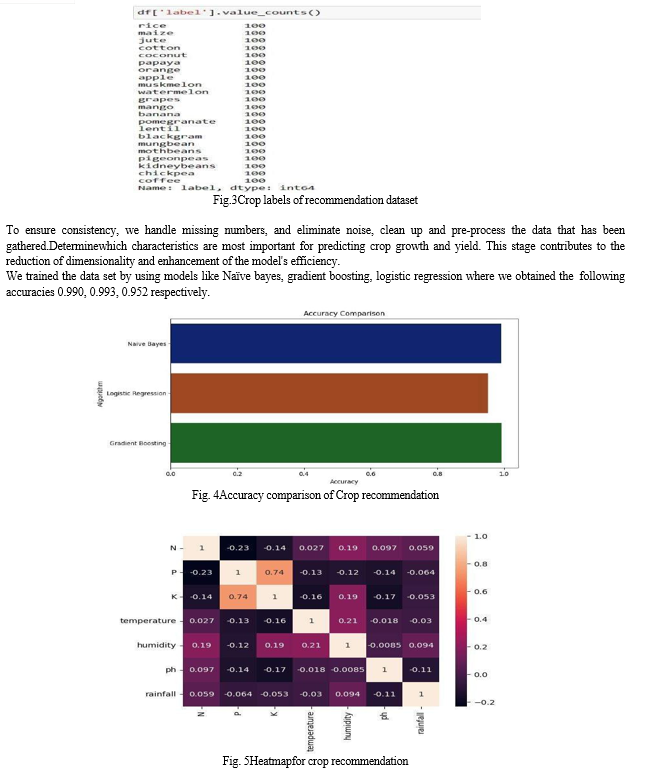


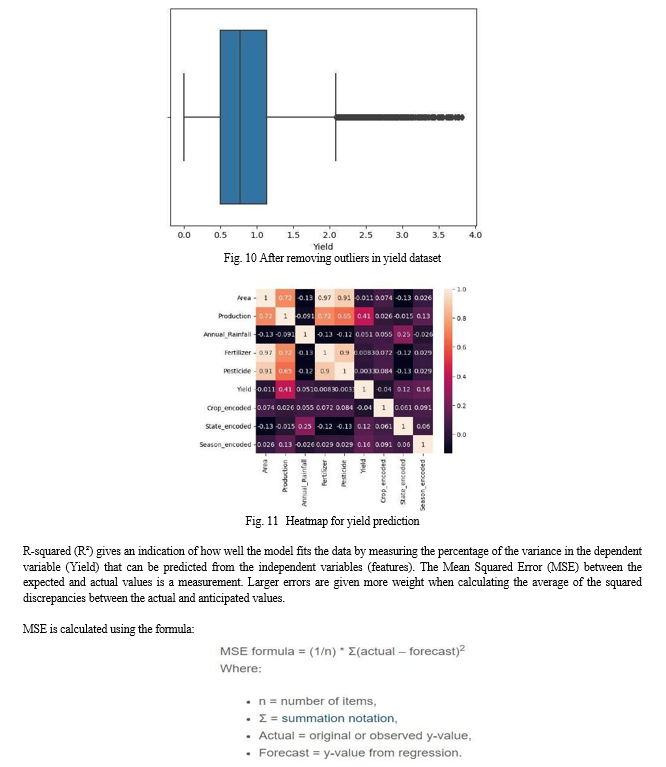
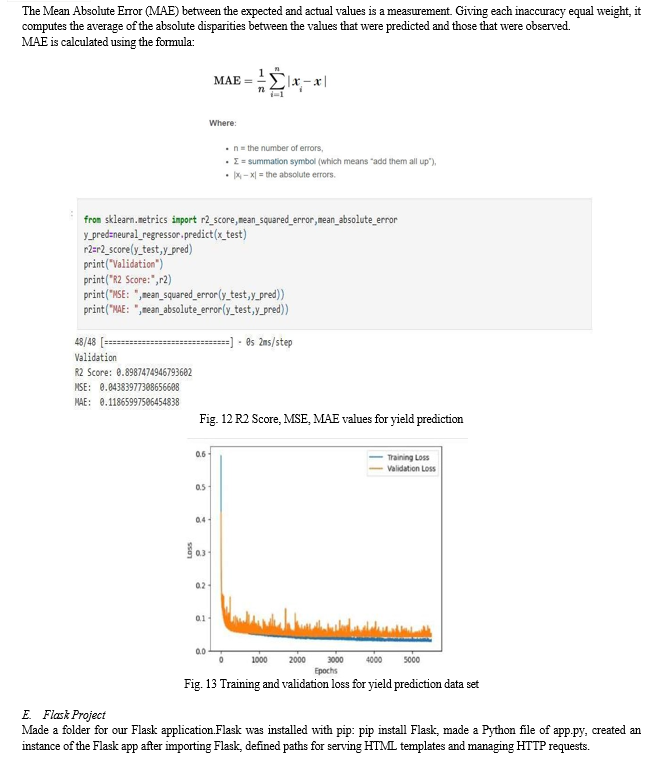


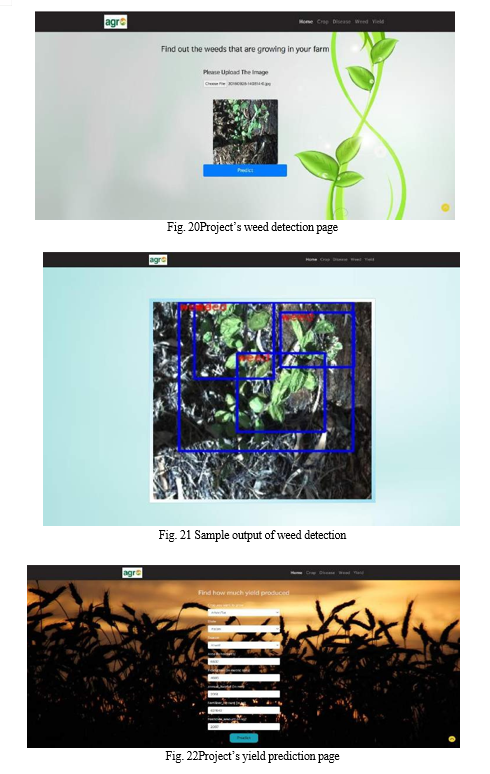
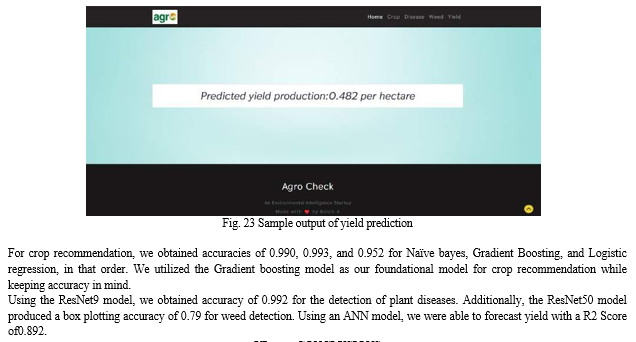
VI. LIMITATIONS
- The models' efficacy is largely dependent on the quantity and caliber of available data. Reliability of data is often limited, particularly in rural or isolated places, which can make predictions and recommendations less accurate.
- Environments and farming communities differ greatly in terms of agricultural practices. Due to variations in soil types, climatic trends, and farming practices, models trained on data from one place could not generalize well to others.
- Crop growth and productivity can be greatly impacted by localized factors like pest outbreaks, soil variances, and microclimates. Models that don't take this unpredictability into consideration could provide incorrect forecasts or suggestions.
- For farmers and other agricultural stakeholders to use the system efficiently, training and assistance may be needed. To optimize the system's impact and encourage adoption, it is imperative to ensure that the interfaces are easy to use and to provide teaching resources.
- The system needs to be updated and maintained on a regular basis due to the dynamic nature of agricultural and environmental circumstances. Maintaining the system's relevance and efficacy over time requires constant observation, model retraining, and adaptation to shifting circumstances.
VII. FUTURE WORK
Increase the quantity and Caliber of data gathered, obtaining more representative and varied datasets on crop yields, weather patterns, soil composition, and pest and disease incidences. For real-time monitoring, combine data from IoT sensors and satellite pictures. Refine and optimize machine learning models for yield prediction, weed identification, and crop recommendation on a continuous basis. To increase accuracy and robustness, investigate cutting-edge strategies like transfer learning, ensemble approaches, and deep learning architectures.
Create adaptable models that can dynamically modify forecasts and recommendations in response to shifting weather patterns, new pest and disease outbreaks, and changing agricultural techniques. Put algorithms for reinforcement learning into practice to facilitate ongoing learning and adaption.Incorporating Stakeholder Input: Work closely with farmers, agricultural specialists, and other stakeholders to get input on how well the crop monitoring system works. To better serve end users' demands, incorporate user feedback into feature development and system design.
VIII. CKNOWLEDGMENTS
- The project's development was made possible by the insightful and helpful input from farmers and agricultural specialists, who guaranteed the project's applicability and relevance in actual agricultural contexts.
- The writers of the literature and articles that were cited, whose studies served as the basis for the project's conception and execution. Novel methods for crop recommendation, weed identification, and yield prediction were inspired by their inventive work in the disciplines of computer vision, agriculture, and machine learning.
- The Flask community for creating and managing a top-notch web framework that made it easier to combine front-end and back-end code, allowing developers to create interactive web apps that benefit stakeholders and farmers alike.
- The creators and providers of the JavaScript, HTML, and CSS libraries, whose resources and tools were crucial in creating and executing the crop monitoring system's interactive features and user interface.
- For all of teamwork aid, advice, and collaboration over the course of the project have enabled us to refine thoughts, get past roadblocks, and accomplish project objectives. We owe a debt of gratitude to Dr. N. Sri Hari, our project coordinator and mentor, for his invaluable advice, encouragement, and perceptive criticism during the course of the project. Their knowledge and support have been crucial in helping us develop our strategy and overcome obstacles.
Conclusion
In conclusion, the AI-powered crop recommendation and monitoring project offers a viable solution to some of the major issues facing agriculture today, including yield prediction, weed and disease detection, and optimal crop selection. Through the application of machine learning algorithms and image processing techniques, the initiative seeks to offer farmers insightful advice on how to improve profitability, sustainability, and productivity.Throughout the project, a variety of machine learning models are used to analyse numerical and image datasets for crop recommendation, weed detection, and yield prediction. These models include Gaussian Naive Bayes, Logistic Regression, Gradient Boosting, Ensemble, and Artificial Neural Networks. The system gains more complexity with the incorporation of sophisticated algorithms such as ResNet for pixel-level identification of diseases and weeds. The creation of an intuitive online interface makes crop monitoring and suggestion tools easily accessible, enabling farmers to make well-informed decisions based on variables including soil composition, meteorological conditions, and historical data. To help farmers manage their crops moresuccessfully, the system also offers contact information for agricultural professionals and cures to safeguard crops.Even though the initiative has a lot of potential to improve agricultural practices, it\'s crucial to be aware of its limits, which include infrastructural restrictions, contextual considerations, and data quality and availability. In order to ensure the project\'s relevance and impact in a variety of agricultural settings, it will be imperative to address these issues.
References
[1] Thilakarathne, N. N., Bakar, M. S. A., Abas, P. E., & Yassin, H. (2022). A cloud enabled crop recommendation platform for machine learning-driven precision farming. Sensors, 22(16), 6299. [2] Restrepo-Arias, J. F., Branch-Bedoya, J. W., &Awad, G. (2022). Plant Disease Detection Strategy Based on Image Texture and Bayesian Optimization with Small Neural Networks. Agriculture, 12(11), 1964. [3] Marion, R. (2020). Machine Learning Based Predictive Farmland Optimization and Crop Monitoring System. Hindawi. [4] Assous, H. F., AL-Najjar, H., Al-Rousan, N., & AL-Najjar, D. (2023). Developing a Sustainable Machine Learning Model to Predict Crop Yield in the Gulf Countries. Sustainability, 15(12), 9392. [5] Elbasi, E., Zaki, C., Topcu, A. E., Abdelbaki, W., Zreikat, A. I., Cina, E., ... & Saker, L. (2023). Crop Prediction Model Using Machine Learning Algorithms. Applied Sciences, 13(16), 9288. [6] Ranjan, P., Garg, R., & Rai, J. K. (2022, December). Artificial Intelligence Applications in Soil & Crop Management. In 2022 IEEE Conference on Interdisciplinary Approaches in Technology and Management for Social Innovation (IATMSI) (pp. 1-5). IEEE. [7] Islam, N., Rashid, M. M., Wibowo, S., Xu, C. Y., Morshed, A., Wasimi, S. A., ... & Rahman, S. M. (2021). Early weed detection using image processing and machine learning techniques in an Australian chilli farm. Agriculture, 11(5), 387. [8] Vaidhehi, M., & Malathy, C. (2022).A unique model for weed and paddy detection using regional convolutionalneural networks. ActaAgriculturae Scandinavica, Section B—Soil & Plant Science, 72(1), 463-475. [9] Elbasi, E., Mostafa, N., AlArnaout, Z., Zreikat, A. I., Cina, E., Varghese, G., ... & Zaki, C. (2022). Artificial intelligence technology in the agricultural sector: a systematic literature review. IEEE Access. [10] Van Klompenburg, T., Kassahun, A., &Catal, C. (2020). Crop yield prediction using machine learning: A systematic literature review. Computers and Electronics in Agriculture, 177, 105709. [11] Assous, H. F., AL-Najjar, H., Al-Rousan, N., & AL-Najjar, D. (2023). Developing a Sustainable Machine Learning Model to Predict Crop Yield in the Gulf Countries. Sustainability, 15(12), 9392. [12] Chang, Y., Latham, J., Licht, M., & Wang, L. (2023). A data-driven crop model for maize yield prediction. Communications Biology, 6(1), 439. [13] Gonzalez-Sanchez, A.; Frausto-Solis, J.; Ojeda-Bustamante, W. Attribute selection impact on linear and nonlinear regression models for crop yield prediction. Sci. World J. 2014, 2014, 509429. [14] Cui, Z., Henrickson, K., Ke, R., & Wang, Y. (2019). Traffic graph convolutional recurrent neural network: A deep learning framework for network-scale traffic learning and forecasting. IEEE Transactions on Intelligent Transportation Systems, 21(11), 4883-4894. [15] Rashid, M., Bari, B. S., Yusup, Y., Kamaruddin, M. A., & Khan, N. (2021). A comprehensive review of crop yield prediction using machine learning approaches with special emphasis on palm oil yield prediction. IEEE access, 9, 63406-63439. [16] Vashisht, S., Kumar, P., & Trivedi, M. C. (2022, April). Improvised extreme learning machine for crop yield prediction. In 2022 3rd International Conference on Intelligent Engineering and Management (ICIEM) (pp. 754-757). IEEE. [17] Cedric, L. S., Adoni, W. Y. H., Aworka, R., Zoueu, J. T., Mutombo, F. K., Krichen, M., &Kimpolo, C. L. M. (2022). Crops yield prediction based on machine learning models: Case of West African countries. Smart Agricultural Technology, 2, 100049. [18] Bhadouria, R., Singh, R., Singh, V. K., Borthakur, A., Ahamad, A., Kumar, G., & Singh, P. (2019). Agriculture in the era of climate change: Consequences and effects. In Climate change and agricultural ecosystems (pp. 1-23). Woodhead Publishing. [19] Sri Hari Nallamala, Dr. Pragnyaban Mishra, KLEF, Dr. Suvarna Vani Koneru, VRSEC, Breast Cancer Detection using Machine Learning Way, International Journal of Recent Technology and Engineering (IJRTE), Vol.8, Issue-2S3, July 2019, ISSN: 2277-3878. [20] Sri Hari Nallamala, Dr. Pragnyaban Mishra, KLEF, Dr. Suvarna Vani Koneru, VRSEC, Pedagogy and Reduction of K-NN Algorithm for Filtering Samples in the Breast Cancer Treatment, International Journal of Scientific & Technology Research (IJSTR), Vol.8, Issue 11, November 2019, ISSN: 2277-8616. [21] N B Naidu, Sri Hari Nallamala, Chukka Swarna Lalitha, Syed Seema Anjum, VVIT, Pertaining Formal Methods for Privacy Protection, International Journal of Grid & Distributed Computing,ISSN: 2005-4262, Vol. 13, No. 1, March – 2020. [22] Kranthi Madala, Sushma Chowdary Polavarapu, VRSEC, Sri Hari Nallamala, Automatic Signal Indication System through Helmet, International Journal of Advanced Science and Technology, Vol. 29, No. 05, April/May – 2020, ISSN: 2005-4238. [23] Sri Hari Nallamala, Dr. D. Durga Prasad, PSCMRCET, J. Ranga Rajesh, MICT, Dr. Pragnaban Mishra, KLEF, Sushma Chowdary P, VRSEC, A Review on Applications, Early Successes & Challenges of Big Data in Modern Healthcare Management, TEST Engineering and Management Journal,Vol. 83, Issue 3, May – June 2020, ISSN: 0193-4120. [24] K B Prakash, KLEF, Rama Krishna E, NEC, Nalluri Brahma Naidu, Sri Hari Nallamala, VVIT, Dr. Pragyaban Mishra, P Dharani, KLEF, Accurate Hand Gesture Recognition using CNN and RNN Approaches, International Journal of Advanced Trends in Computer Science and Engineering, Vol. 9, No. 3, May – June 2020, ISSN: 2278-3091. [25] Sushma Chowdary P, Kranthi Madala, VRSEC, M Sailaja, PVPSIT, Sri Hari Nallamala, Investigation on IoT System Design & Its Components, Jour of Adv Research in Dynamical & Control Systems, Vol. 12, Issue-06, June – 2020, ISSN: 1943-023X. [26] Sri Hari Nallamala, Bajjuri Usha Rani, LBRCE, Anandarao S, LBRCE, Dr. Durga Prasad D, PSCMRCET, Dr. Pragnyaban Mishra, KLEF, A Brief Analysis of Collaborative and Content Based Filtering Algorithms used in Recommender Systems, IOP Conference Series: Materials Science and Engineering, 981(2), 022008, December 2020, ISSN: 1757-899X. [27] Manukonda Vinay, Gonugunta Bhanu Sankara Sai Venkatesh, Malempati Venkata Priyanka, Dogiparthi Venkata Sai, Dr. Sri Hari Nallamala, VVIT, Deep Learning Based Face Mask Detection for User Safety from Covid-19, International Journal of Innovative Research in Computer and Communication Engineering (IJIRCCE), e-ISSN: 2320-9801, p-ISSN: 2320-9798, Volume 10, Issue 5, May 2022. [28] P. Radha Vyshnavi, M.V.N. Sai Niharika, M. Summayya, P. Pravallika, Dr. Sri Hari Nallamala, VVIT, Liver Disease Prediction Using Machine Learning, International Journal of Innovative Research in Science, Engineering and Technology (IJIRSET), e-ISSN: 2319-8753, p-ISSN: 2320-6710, Volume 11, Issue 6, June 2022. [29] Y. Vineela Devi, T.Akshara, S.Mohitha, V.Venkatesh, N.Sri Hari, VVIT, Precision Farming By Analysing Soil Moisture and NPK Using Machine Learning, International Journal of Innovative Research in Science, Engineering and Technology (IJIRSET), e-ISSN: 2319-8753, p-ISSN: 2320-6710, Volume 11, Issue 6, June 2022. [30] Dr. N. Sri Hari, M. Ramya Sri, Mythri .P, N. Sai Harshitha, M. VenkataNaga Sai Kumar, Detection of Covid-19 using Deep Learning, IJFANS INTERNATIONAL JOURNAL OF FOOD AND NUTRITIONAL SCIENCE, UGC CARE Listed (Group -I) Journal, Volume 11, Iss 12, Dec 2022; P- ISSN: 2319 1775, Online-ISSN: 2320 7876. [31] Dr. N. Sri Hari, P. Vanaja, M. Ajay Kumar, M.D.V.S. Akash, K. Sivaiah, Multi Disease Detection using Machine Learning, IJFANS INTERNATIONAL JOURNAL OF FOOD AND NUTRITIONAL SCIENCE, UGC CARE Listed (Group -I) Journal, Volume 11, Iss 12, Dec 2022; P-ISSN: 2319 1775, Online-ISSN: 2320 7876. [32] Dr.N.Sri Hari, Shaik Nelofor, Siramdasu Leela Vardhan, Sura Rana Prathap Reddy, Sakhamuri Devendra, CycleGAN Age Regressor, International Journal for Innovative Engineering and Management Research, ISSN: 2456-5083, Volume 12, ISSUE 04, Pages: 45-51, April 2023. [33] Sudheer Mangalampalli, Ganesh Reddy Karri, Amit Gupta, Tulika Chakrabarti, Sri Hari Nallamala, Prasun Chakrabarti, Bhuvan Unhelkar, Martin Margala, Fault-Tolerant Trust-Based Task Scheduling Algorithm Using Harris Hawks Optimization in Cloud Computing, Sensors 2023, 23(18), 8009; https://doi.org/10.3390/s23188009. [34] K. Sudharson, …, Sri Hari Nallamala, et al., Hybrid Quantum Computing and Decision Tree based Data Mining for Improved Data Security, 7th International Conference On Computing, Communication, Control And Automation (ICCUBEA), August 18-19, 2023, 979-8-3503-0426-8/23/$31.00 [35] ©2023 IEEE. [36] G Sanjay Gandhi, K Vikas, V Ratnam, K Suresh Babu,IET Communications 14 (16), 2840-2848 ,Grid clustering and fuzzy reinforcement?learning based energy?efficient data aggregation scheme for distributed WSN [37] KV Prasad, GS Gandhi, S Balaji , Inexpensive colour image segmentation by using mean shift algorithm and clustering,, International Journal of Graphics and Image Processing 4 (4), 260-266 [38] PSK venkatraomaddumala, sanjay gandhi gundabatini, P AnushaClassification of Cancer cells detection using Machine Learning Concepts,International Journal of Advanced Science and technology 29 (3), 9177-9190 [39] Sanjay Gandhi Gundabatini, Suresh Babu Kolluru, C. H. Vijayananda Ratnam & N. Nalini Krupa ,. DAAM: WSN Data Aggregation Using Enhanced AI and ML Approaches Conference paper First Online: 27 June 2023,LNEE,volume 976 [40] Gundabatini, S.G. Rayachoti, E., Vedantham, R Recurrent Residual Puzzle based Encoder Decoder Network (R2-PED) model for retinal vessel segmentation. Multimed Tools Appl (2023). https://doi.org/10.1007/s11042-023-16765-0 [41] Gundabatini, S.G.Rayachoti, E., Vedantham, R EU-net: An automated CNN based ebola U-net model for efficient medical image segmentation. Multimed Tools Appl (2024). https://doi.org/10.1007/s11042-024-18482-8
Copyright
Copyright © 2024 Sri Hari Nallamala, Dhanalakshmi Meghana Majeti, Venkata Pranay Pendyala, Sanghamitra Neela, Bhanu Prakash Nambari. This is an open access article distributed under the Creative Commons Attribution License, which permits unrestricted use, distribution, and reproduction in any medium, provided the original work is properly cited.

Download Paper
Paper Id : IJRASET59061
Publish Date : 2024-03-16
ISSN : 2321-9653
Publisher Name : IJRASET
DOI Link : Click Here
 Submit Paper Online
Submit Paper Online

